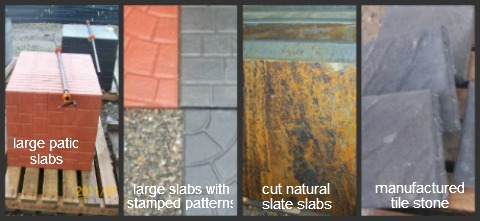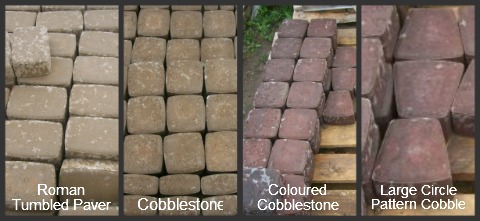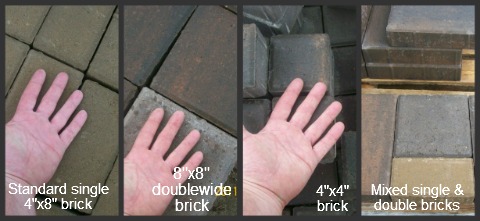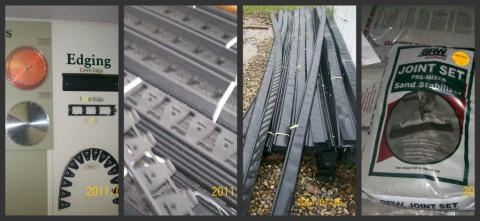C. Patio Bricks and Paver Stones
Patio bricks and paver stones come in many different shapes, sizes, and colors. Some will be easier to work with than others, depending on the landscape
design you have in mind.
This makes choosing the right ones for your design and skill level important.
Unlike wall materials, patio stones allow you to be a little more creative with mixing and matching of different colors and materials.
Just be prepared to do a little more cutting if you have lots of curves or complicated patterns.
If this is too much for you, you should consider leaving it to a professional installer.
This section will hopefully give you some more insight on the manufactured paver materials available and how to estimate your requirements.
Whether you are at the preliminary ideas stage, or putting
your backyard patio ideas and estimates on paper, we hope that this
information is helpful.
Larger Blocks and Slabs
Seen below are from left to right: concrete sidewalk blocks, stamped pattern slabs and exposed aggregate slabs, cut natural stone and architectural slabs.

Patio pavers.
Large sidewalk blocks and architectural slabs usually come in sizes of 12x12, 24x24, 24x30 and 16x16 inches. This makes these products very easy to estimate for a project.
Round stepping stones are also
quite popular for making easy stepping stone pathways. These are often
found in 12, 16, and 20 inch sizes of different materials. (Exposed
aggregate is a popular choice.)
Smaller Bricks and Paver Stones
Smaller bricks and paver stones also come in a variety of colors and sizes. 4x8, 2x8, 8x8, and 2x4 inch are common sizes. Variations in style from regular brick, Euro, and Cobble are found among most manufacturers. You can also find wedge shaped pieces for circle patterns or kits.
"Tumbling" is a practice of rounding off the corners and edges of patio pavers to give them an antique or "old" appearance like the old Roman cobble roads.

Small pavers.
Notice in the above pictures how the cobblestones also have half pieces available. These small wedge pieces make cobblestones easier to work with, saving you from having to cut bricks.
Standard cut landscape bricks These are the easiest to work with for the do-it-yourselfer. If you are building a square or rectangular backyard patio, these are a piece of cake.
They can also be combined in different colors and sizes for easy patterns as seen in the last picture below.

Holland Pavers.
More and more manufactures are also making their own unique
shaped interlock blocks for a more natural look. These come in a variety
of shapes and sizes as well.
Additional products you may need
Lighting
Like wall materials, patio pavers also have low voltage lighting in 4x8, 6x6, 6x9, or other sizes depending on the manufacturer. You can usually buy these individually, or in kits that include the wire, bulbs, sockets, transformer, and lenses.
Edging
Edging will also be available for your backyard patio or paver project. There are different types of edging that are used to prevent lateral movement of your patio or paver bricks. Metal edging or plastic edging is the most common type. These are secured into the ground using spikes that are 8 to 12 inches. (I would recommend the 12 inch spikes.) Patio brick edging is often sold in 7.5 and 8 ft. lengths.

Edging and Polymeric Sand.
There are also decorative edging materials that are made from manufactured bricks and blocks. You can sometimes be creative with these materials and use them in different ways. (Soldiering, is standing bricks on end.)
Jointing sand and polymeric sand
Jointing or polymeric sand, is used to seal the cracks between the pavers, patio stones, and natural stones in a patio. It is usually made up of sand or fine crushed rocks with a binder (Glue), that is either polymer or organic in nature. It will prevent erosion, water, weeds, and insects from settling in the cracks between the stones.
It is generally sold in 50 lb bags that will cover 50 to 75 square feet. The coverage may be less depending on the gap size and depth between the stones.
Jointing sand is most effective when coverage between the stone is at least two inches deep, and the gap sizing of the cracks is two inches or less. Please visit our product profile on jointing sand installation. This joint venture was done with the help of envirobond.
Cleaners and sealers
You will also find materials to clean or seal pavers and patio stones. The cleaners will remove grease, dirt, tar, efflorescence, rust and other things it may be exposed to over the years. By using sealers, you will prevent these stains from happening in the first place. Some people will also use sealers for the "wet look".
Hopefully, you are picking up some helpful information about
manufactured products. Now we can talk about how easy it is to estimate
what you are going to need.
Estimating materials for manufactured pavers
and bricks
Most people will start by having an idea in mind for the area. Once you have this area measured (Length times the width= square area), you should select your product. Once you decide on the product, you can figure out accurate measurements of your project.
As we said earlier in our block section, the coverage information for patio pavers and bricks is in the brochure of the product you are buying. The sales staff in the landscaping yards can also assist you with this information when your order.
The coverage per square foot given by the manufacturer is the information you are looking for. This will be used with your total square foot measurement of the area you want covered.
There are also online calculators and tools to estimate your requirements for landscaping projects, but you should still understand how you get to the basic results.
So read the following section below for quick estimates.
Don't worry if you are over or under a few bricks. Most landscapers are usually off a little as well. The supply yard should take them back if you have a few extras.
Ordering a few extra can save you from having to go back to the yard when you are working on your project. having a few extra bricks tucked away somewhere comes in handy if you have to replace a broken one.
There are always a few different ways to figure out really quick estimates. Here is one more simple way of getting it pretty close.
Let's say you are building a patio that is 12 ft. long by 12 ft. wide.
Convert the length and width of your area in feet to inches (whatever unit measurement the bricks are sold in).
Length
12 ft = 144 inches divided by 8 inches (length of your brick)
= 18 bricks long
Width
12 ft = 144 inches divided by 4 inches (width of your brick)
= 36 bricks wide
18x36 = 648 bricks
Just be careful when doing these quick calculations that your actual dimensions will differ a little because of the gap between the bricks.
For the most accurate measurements, use the manufacturers coverage recommendations. Remember we told you at the start that manufacturers give you a coverage per square foot figure in their brochure.
Things may get a little more interesting when estimating for your
sub-base. We will cover that when we talk about gravel, sand and
aggregates.
Important Tips
Remember that you will have a very small gap between the pavers. The gap can vary with different products. Nothing will be perfectly flush. This is what your jointing sand will be filling in. This is what throws people off with estimating most materials.
Get a basic idea about your measurements using simple formulas like above, but use the manufacturers formulas for more accurate estimating.
I always build my sub-base perimeter about six inches bigger than the actual dimensions. This allows you to have full support under the edges extending past the edge of the brick and the restraint edging.
It will also allow you a few inches of grace if you have to make any minor adjustments to accommodate inaccurate measurements or brick and paver dimensions.
We also talked about this at the start. For beginners, estimating is also easier when working with squares and rectangles than complicated designs. This means with patio and paver materials, you will need to design and build within your abilities.
Let's move on to more products that you may find at landscaping yards. Let's look at Types of Gravel.
______________________________________
Introduction Estimating Materials
Table of Contents: Landscaping Yards
A. Landscaping Yards Introduction
C. Patio Bricks and Paver Stones
F. Buying Rock
H. Other Landscaping Materials
I. Quick Landscaping Estimating Reference
Table of Contents: Buying Soil
______________________________________
Return to the Estimating Materials Introduction
Go to the Dream Yard Home Page
Check out our time and money saving e-book
How to avoid the biggest mistakes made by DIYers, designers, and landscaping companies.
Visitor
Favorites
Giggles 'n' Thoughts





